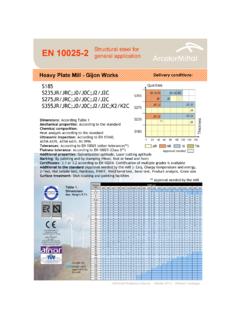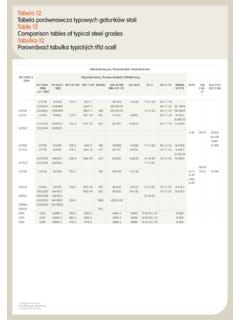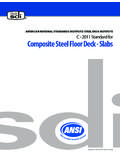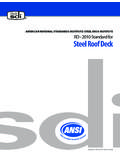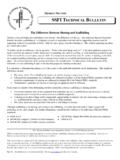Transcription of Design Aids for Unreinforced Web Openings in …
1 Design aids for Unreinforced Web Openings in steel and Composite Beams with W-Shapes GUSTAVO DE SOUZA VER SSIMO. Assistant professor in the Civil Engineering Department Federal University of Vi osa, Vi osa, MG, Brazil. RICARDO HALLAL FAKURY. Professor of structural steel Design in the Structures Engineering Department Federal University of Minas Gerais, Belo Horizonte, MG, Brazil. JOS CARLOS LOPES RIBEIRO. Civil Engineering, graduate research assistant Federal University of Minas Gerais, MG, Brazil Introduction Several factors can impose height limitations in multistory buildings, such as zoning regulations, economic requirements and aesthetic considerations.
2 To minimize floor height, a common solution is to cut Openings into steel beam webs in order to pass utilities through (see Figure 1). If these Openings are Unreinforced , they can significantly reduce the flexural and shear capacity of the beams. bf tf dt Do ho d tw ao dt tf a) Unreinforced opening b) reinforced opening Fig. 1. Openings in steel beams. In the 1960s, 1970s, and 1980s, studies on different web opening configurations were completed in the United States and Canada, including square, rectangular, circular, concentric, and eccentric Openings in both non-composite and composite steel beams.
3 In the late 1980s, Darwin and Donahey (1988), Darwin and Lucas (1990) and Darwin (1990) demonstrated that it is possible to produce a unified procedure embodying the different cases that are frequently used in steel building structures. ENGINEERING JOURNAL / THIRD QUARTER / 20 Copyright C american institute of steel Construction, Inc. 1. Reprinted with permission. All rights reserved Some national standards , such as the British Standard (BSI, 2000) and the Canadian Standard (CSA, 2001), provide simplified rules for opening Design in order to avoid weakening of the beam. However, these rules cover a wide range of possibilities, and, therefore, they are very conservative and, in general, restrict the Openings to the middle third of the beam depth and to the two central quarters of the beam span.
4 By fixing some parameters, it would be possible to get more flexible and economical results for typical situations in the floors of buildings. This work presents the results of computational simulations in non-composite and composite steel beams with web Openings , based on a unified procedure developed by Darwin (1990), and it is limited to W-shape sections. Design aids are provided that allow the identification of the beam region where Unreinforced Openings with specific characteristics do not reduce the member capacity. Application of these Design aids avoids the use of complex and expensive analytical calculation methods.
5 The Design aids are compatible with the Load and Resistance Factor Design Specification for Structural steel Buildings (AISC, 1999-a) and can serve as a supplemental reference to that specification. Range of application The Design aids were developed for non-composite and composite steel W-shape sections with the followings limitations: d > (1). bf h E. (2). tw Fy bf E. (3). 2t f Fy where d = overall depth of steel section h = clear distance between flanges less the corner radius tw = web thickness bf = flange width tf = flange thickness E = modulus of elasticity of steel Fy = yield stress of the steel The beams shall be simply supported and subject to a factored uniformly distributed load.
6 They must have appropriate lateral bracing to avoid lateral-torsional buckling. The steel shall have maximum yield strength of 50 ksi (350 MPa). In composite beams, the slab can be normal weight concrete or lightweight concrete with a specified compressive strength, fc', of not more than ksi (45 MPa). In addition, the slab shall have total thickness not greater than in. (160 mm) and effective width not greater than 118 in. (3000 mm). These restrictions are applied to both solid concrete slab and concrete slab on formed steel deck. The steel -concrete interaction can be full or partial and the construction shored or unshored.
7 ENGINEERING JOURNAL / THIRD QUARTER / 20 Copyright C american institute of steel Construction, Inc. 2. Reprinted with permission. All rights reserved The Openings considered have the following shapes: square, rectangular with aspect ratio equal to 2 (length ao equal to twice the depth ho as shown in Figure 1) and circular. The span-depth ratio of the beams, L/d, shall be in the range of 10 to 30. For composite beams, this ratio refers only to steel profile. The corners of square and rectangular Openings should have minimum radii at least twice the thickness of the web, tw, or 5/8 in. (16 mm), whichever is greater, in order to avoid fatigue cracking due to stress concentration at these points (Darwin, 1990).
8 Methodology The principal aim of this paper is to identify, by means of the procedure proposed by Darwin (1990), the region where one concentric opening with a certain shape and dimensions does not cause reduction on the beam strength. Knowing the location of this region, called the neutral zone and represented by the hatched area in Figure 2, it is possible to Design web Openings without considering the beam net section, which dispenses of analytical calculation methods. The neutral zone depth, hnz, is symmetrically positioned with respect to the centroid of the steel section and can be defined as twice the web opening half-depth plus the opening eccentricity (Figure 2).
9 Obviously, for Openings symmetrically positioned with respect to the centroid of the steel section (concentric opening ), hnz is the opening depth itself. neutral zone S. d hnz L/2 L/2. kL Lnz kL. Fig. 2. Neutral zone. The neutral zone length, Lnz (Figure 2), for each case studied is the beam length where the moment-shear interaction is not considered as critical. For this, the following expression is used (Darwin, 1990): 3 3. M u Vu . + 1 (4). M m Vm . where Mu = required flexural strength at opening centerline Vu = required shear strength at opening centerline Mm = maximum nominal flexural strength at the location of an opening under pure bending; it occurs when Vu = 0 at opening centerline Vm = maximum nominal shear strength at the location of an opening under pure shear; it occurs when Mu = 0 at opening centerline = resistance factor, equal to for steel beams and for composite beams ENGINEERING JOURNAL / THIRD QUARTER / 20 Copyright C american institute of steel Construction, Inc.
10 3. Reprinted with permission. All rights reserved The nominal flexural and shear strengths at the location of an opening , Mm and Vm, depend on (a) the shape and dimensions of the concentric opening and (b) the nominal flexural and shear strengths, respectively Mn and Vn, respectively, of the non-composite or composite steel beam with an unperforated web. Darwin (1990) supplies the method for obtainment of these values. The required flexural and shear strengths are calculated in several intermediary sections, equally spaced along midspan, L/2, with the following classical equations from the theory of structures: M u ( zo ) =.
